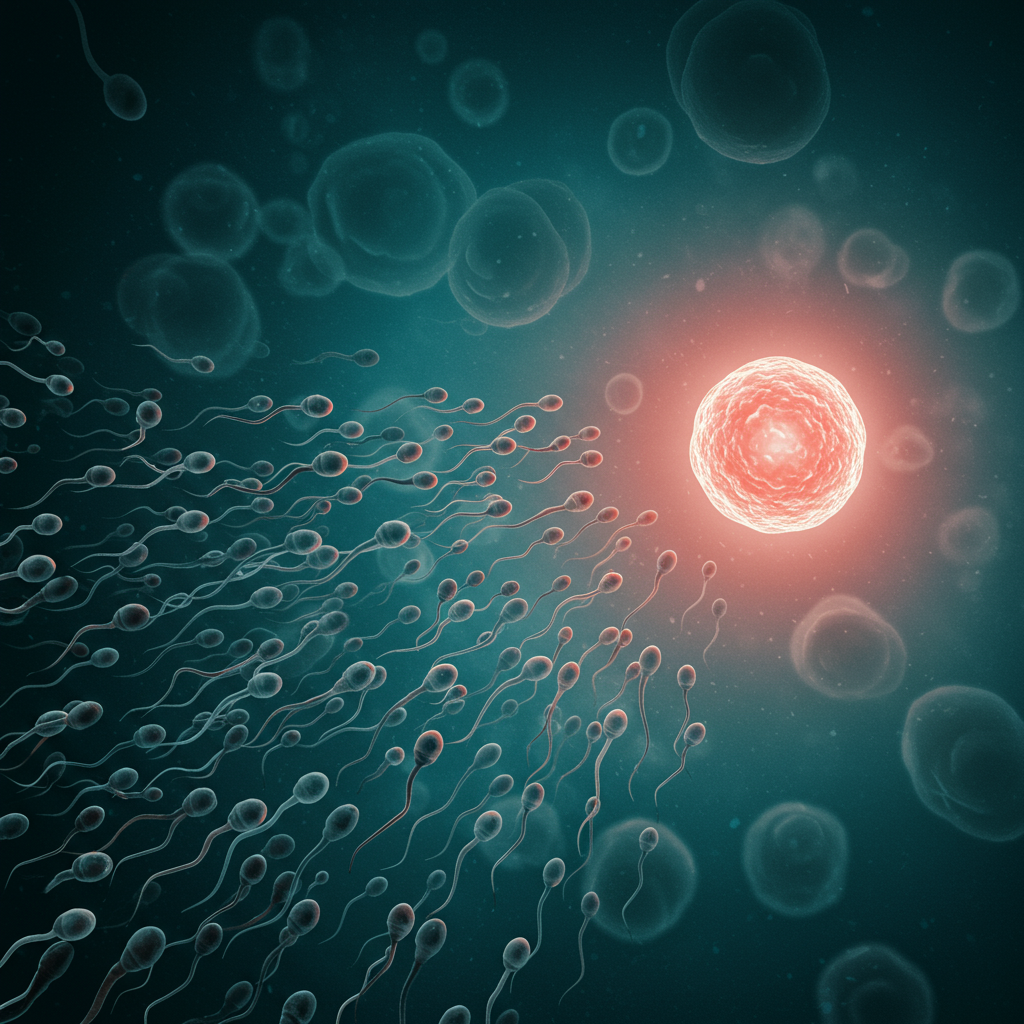With every heartbeat, a man can produce around 1,000 sperm. Incredibly, during intercourse, over 50 million of these intrepid cells embark on an epic quest to fertilize a single egg. This microscopic journey culminates with just one triumphant sperm penetrating the egg.
Yet, despite this fundamental role in life and centuries of scientific inquiry, much about sperm – and their incredible voyage – remains shrouded in mystery. Questions like: How do sperm swim with such purpose? How do they navigate the complex female reproductive tract? What exactly are they made of beyond just DNA? These fundamental questions continue to puzzle scientists.
“There’s a huge amount that we don’t understand,” explains Sarah Martins da Silva, a clinical reader in reproductive biology at the University of Dundee. Almost 350 years after their initial discovery, many aspects of sperm biology are still surprisingly open to debate and active research.
Using cutting-edge techniques, researchers are now following sperm through their entire lifecycle, from formation in the testes to their arrival at the egg. These efforts are yielding groundbreaking insights, challenging long-held assumptions and revealing the dramatic transformations sperm undergo, particularly after entering the female body.
The Unique Biology of a Sperm Cell
Sperm cells, or spermatozoa, are unlike any other cell type in the human body. “They are very, very different from all other cells on Earth,” notes Martins da Silva. Their unique characteristics include:
Distinct Metabolism: They handle energy and metabolism in ways not seen in typical cells.
High Energy Demands: The demanding journey and complex functions require significantly more energy than other cells.
Exceptional Flexibility: Sperm must adapt rapidly to varying environmental conditions and energy needs during ejaculation and their passage through the female tract.
Survival Outside the Body: Uniquely among human cells, sperm can survive outside the body under specific conditions, highlighting their extraordinary specialization.
Their tiny size, however, makes them notoriously difficult to study, adding another layer to the mystery.
Beyond “A Bag of DNA on a Tail”
For centuries, the understanding of sperm was rudimentary. “We typically thought of the sperm as a bag of DNA on a tail,” says Adam Watkins, an associate professor in reproductive physiology at Nottingham University.
The scientific journey into sperm began in 1677 with Dutch microbiologist Antoni van Leeuwenhoek, who observed “semen animals” under his homemade microscope. By the 1680s, he theorized that a miniature human existed within these “animalcules.” Later, Swiss physician Johannes Friedrich Miescher, while studying white blood cells, discovered “nuclein” (later identified as DNA) in 1869. Seeking a richer source, he turned to salmon sperm, identifying “protamine,” a basic protein component, in 1874. However, it took another 150 years for scientists to fully catalogue the protein contents of sperm cells.
Today, scientists recognize sperm as far more complex. It’s not just the father’s chromosomes being passed on, but also critical epigenetic information – an extra layer of data influencing how and when genes are expressed. This epigenetic cargo carried by sperm can significantly impact embryonic development and potentially shape the lifelong health trajectory of the offspring.
The Incredible Journey Begins
Sperm production starts at puberty within the testicles. Beginning as simple round cells, they undergo a dramatic, unique transformation into the distinctive head-and-tail structure over about nine weeks. Unused sperm are reabsorbed by the body, while the “lucky” ones are ejaculated.
After ejaculation, the real adventure begins. Millions of sperm compete, propelled by their tails towards the egg. While early depictions showed a simple side-to-side swimming motion, recent research has unveiled a more complex reality. In 2023, studies applying principles from World War Two codebreaker and mathematician Alan Turing’s theory of pattern formation (specifically, his “reaction-diffusion” idea) found that sperm tails, or flagella, undulate in waves. Understanding this true swimming mechanism is crucial for understanding male fertility.
Navigating the Unknown Maze
Once moving, sperm face the daunting task of navigating the female reproductive tract – a labyrinth through the cervix, womb, and into the fallopian tubes (oviducts) where the egg resides. How they find their way is another major puzzle. Many sperm take wrong turns, never reaching the egg.
Scientists theorize that the successful few may be guided by chemical signals emitted by the egg itself. One intriguing recent idea even suggests sperm might use “taste receptors” to sense their way towards the target.
Breaching the Egg’s Defenses
Reaching the egg isn’t the end; it’s the next challenge. The egg is protected by multiple layers: the cellular corona radiata, the protein-rich zona pellucida, and the plasma membrane. Sperm must fight through these defenses. They use enzymes contained in the acrosome, a cap-like structure on the sperm head, to digest the egg’s outer layers. However, the precise trigger for the release of these critical enzymes remains unknown. Sperm also use forceful tail thrashing to push forward.
Fertilization occurs when a single sperm successfully penetrates the egg membrane and is engulfed. To prevent polyspermy (multiple sperm fusing with the egg, a lethal condition for the embryo), the egg employs rapid defense mechanisms: a quick electrical depolarization of its membrane, followed by the cortical reaction, where calcium release hardens the zona pellucida, creating an impenetrable barrier.
The final act – how the sperm and egg truly recognize, bind, and fuse – involves complex cell surface proteins. While some crucial proteins have been identified in other species like mice and fish, many of the molecules involved in human sperm-egg interaction are still being uncovered, leaving their precise recognition and fusion a continuing mystery.
The Female Tract: Driving Sperm Evolution?
To gain deeper insights, researchers often study species beyond humans. Scott Pitnick, a biology professor at Syracuse University, studies fruit flies, some of which produce sperm cells astonishingly large – up to 20 times their body length, comparable to a human producing sperm the length of a python.
Pitnick’s work suggests that the rapidly evolving female reproductive tract may be a primary driver of sperm diversity and evolution. Rather than males solely dictating sperm traits, the female environment might actively select for specific sperm characteristics, effectively turning large sperm into “ornaments” used in post-mating sexual selection within the female body. This challenges the historical scientific bias towards focusing only on male traits, highlighting the significant, often unexplored, interactions between sperm and the female body, including crucial maturation steps that occur after ejaculation. Sperm, it turns out, are not fully developed until they interact with the female environment.
A Modern Crisis: The Decline in Sperm Counts
Adding urgency to understanding sperm biology is the alarming global decline in sperm counts. While men produce a vast number of sperm over a lifetime, studies suggest counts are falling, potentially accelerating in recent years.
The World Health Organisation (WHO) reported in 2023 that roughly one in six adults worldwide experience infertility, with male infertility contributing to about half of these cases. While factors like pollution, smoking, alcohol, poor diet, lack of exercise, and stress are linked to male infertility, the cause for the majority of men with fertility problems remains unexplained.
Understanding the fundamental function of sperm is seen as key to diagnosing and treating male infertility. Assessing sperm quality goes beyond just count; it involves examining factors like DNA packaging and fragmentation. However, scientists still lack standardized metrics for what constitutes “good” versus “bad” sperm quality, underscoring how much remains unknown at the cellular level.
In unraveling the many mysteries of sperm, from their unique biology and epic journey to their complex interactions with the female body and their worrying modern decline, scientists hope to not only deepen our understanding of life’s beginnings but also find solutions to the growing challenge of male infertility. Despite centuries of study, the tiny sperm cell remains one of biology’s most fascinating and enduring enigmas.




